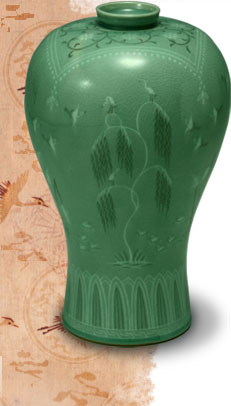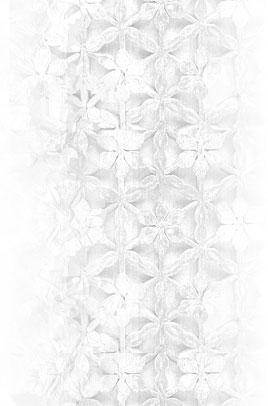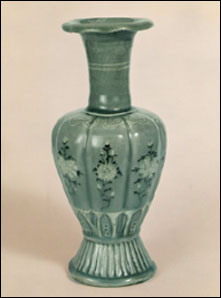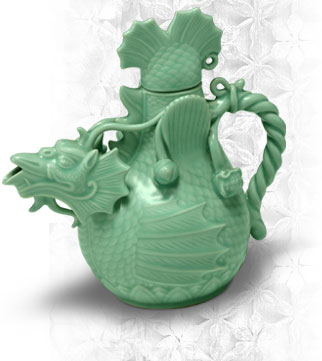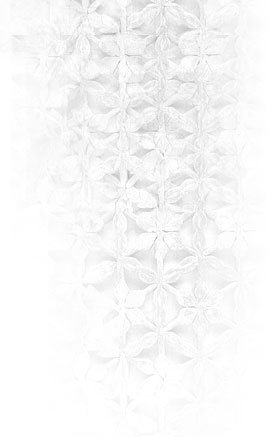 The
color of the autumn sky right after a heavy rain shower is recreated
on earth through Goryeo celadon ceramic The
color of the autumn sky right after a heavy rain shower is recreated
on earth through Goryeo celadon ceramic
 ware.
Potters from the Goryeo Dynasty (918-1392) tinted their pottery works
with a piece of the clear autumn sky, ware.
Potters from the Goryeo Dynasty (918-1392) tinted their pottery works
with a piece of the clear autumn sky,
 demurely
revealed through dark clouds after a heavy rainfall. The mysterious bluish-green
color of celadon pottery demurely
revealed through dark clouds after a heavy rainfall. The mysterious bluish-green
color of celadon pottery
 defies
any man-made dye. It is the epitome of natural beauty that cannot be acquired
from any scientific color defies
any man-made dye. It is the epitome of natural beauty that cannot be acquired
from any scientific color
 combination
using modern technology. combination
using modern technology.
 Celadon
pottery was first made in China, where potters from the Northern and Southern
Dynasties discovered Celadon
pottery was first made in China, where potters from the Northern and Southern
Dynasties discovered
 that
when ash landed on ceramic works being fired in kilns at a high temperature,
the result was a wonderful that
when ash landed on ceramic works being fired in kilns at a high temperature,
the result was a wonderful
 blue
coat. The ash formed from burning wood chemically reacted with the clay
to create a natural glaze which blue
coat. The ash formed from burning wood chemically reacted with the clay
to create a natural glaze which
 hardened
into a beautiful bluish finish when baked at 1300° Celsius inside the
kilns. The technique of celadon hardened
into a beautiful bluish finish when baked at 1300° Celsius inside the
kilns. The technique of celadon
 making
was refined during the Tang Dynasty but was elevated to the zenith of
its artistry during the Sung Dynasty making
was refined during the Tang Dynasty but was elevated to the zenith of
its artistry during the Sung Dynasty
 in
the 12th century. in
the 12th century.
 Korean
potters who were introduced to China’s celadon making techniques
in the mid-9th century began a new era Korean
potters who were introduced to China’s celadon making techniques
in the mid-9th century began a new era
 and
aestheticism of celadon pottery by introducing their own unique skills and
methods to the world. When celadon pottery and
aestheticism of celadon pottery by introducing their own unique skills and
methods to the world. When celadon pottery
 reached
its artistic peak in 12th-century China, a new set of celadon-making techniques
was being established by reached
its artistic peak in 12th-century China, a new set of celadon-making techniques
was being established by
 Korean
potters. Although celadon pottery from the Sung Dynasty is known for its
majestic forms, extravagant Korean
potters. Although celadon pottery from the Sung Dynasty is known for its
majestic forms, extravagant
 decorations, and opaque
glazing, Goryeo celadon works feature natural, subtle forms perfectly
and harmoniously in decorations, and opaque
glazing, Goryeo celadon works feature natural, subtle forms perfectly
and harmoniously in  balance
with soft, rhythmic lines and clear glazing. Until the 17th century, when
Japan acquired the skills and balance
with soft, rhythmic lines and clear glazing. Until the 17th century, when
Japan acquired the skills and  practices
of pottery-making through the kidnapping of Korean potters during the
Japanese invasion, only Korea and China had the technology to create high-quality
earthenware baked at very high temperatures. Many European countries imported
celadon and other pottery styles from China until the 18th century when
they finally launched their own unique ceramic methods. practices
of pottery-making through the kidnapping of Korean potters during the
Japanese invasion, only Korea and China had the technology to create high-quality
earthenware baked at very high temperatures. Many European countries imported
celadon and other pottery styles from China until the 18th century when
they finally launched their own unique ceramic methods.
There are several factors that set
Goryeo celadon apart from others in the realm of ceramics
history. First of all, the “mysterious color” unique to Goryeo celadon
was even referred to by
celebrated Goryeo poet, Yi Gyu-bo, as a piece stolen of “heavenly harmony.”
The color that
envelops viewers with mysterious reflection, as if they are looking into
the deep waters of a
calm lake, became the subject of admiration even by Chinese people who
had introduced
the ware. In fact, a scholar from the Sung Dynasty declared in his writing
that Goryeo
celadon was one of the best things in the world, surpassing China in the
art of
celadon pottery, and that the rich, vivid color of Goryeo celadon was the
“best under heaven.”
Secondly, potters from the Goryeo Dynasty applied
a unique decorative
practice to their celadon pottery making – the wonderful art of inlaying,
the first
of its kind in the world. Inlaid celadon is made by incising the desired
motifs onto the
surface of a vessel and filling in the area with white or red slip (clay
mixture) before
applying the glaze. After firing, the white slip remains the same color
while the
red slip turns black. The inlaying technique requires not only the highly
refined
skill of balancing completely different materials but also a dexterous
incising
ability as well as elegant taste, all of which go hand in hand with the
sophisticated refinement of celadon pottery. This new technique resulted
in an innovative change in celadon decoration. The conventional intaglio
and relief techniques only allowed subtle decoration of a vessel; however,
the introduction of the inlaying approach that resulted in vivid patterns
shown through a thin layer of clear blue glaze marked the beginning of
a new celadon era. Some of the most popular motifs include cranes, clouds,
willow trees, grapes, children, lotus flowers, peonies, and chrysanthemums
that reflect the longing for the eternal world and the lyrical awareness
of the natural world by the Goryeo people. These motifs mesh perfectly
with the mysterious jade color of Goryeo celadon, thus creating the most
beautiful art work made of earth.

 Melon-shaped
Celadon Vase Inlaid with Peonies and Chrysanthemums Melon-shaped
Celadon Vase Inlaid with Peonies and Chrysanthemums
 Goryeo,
12th Century Goryeo,
12th Century
 25.6cm
in height and 10.9cm in diameter at its widest point 25.6cm
in height and 10.9cm in diameter at its widest point
 This
vase is an impressive example of inlaid celadon works. It adopts the shape This
vase is an impressive example of inlaid celadon works. It adopts the shape
 of
a blooming morning glory flower in the mouth, a melon with eight round of
a blooming morning glory flower in the mouth, a melon with eight round
 sections
in the body, and pleated skirts in the flared foot to achieving a rhythmic sections
in the body, and pleated skirts in the flared foot to achieving a rhythmic
 body
harmoniously balanced. An indeterminate flare of the foot blends in with body
harmoniously balanced. An indeterminate flare of the foot blends in with
 the
mouth of the vase shaped as nine petals of a flower to emit the air of
warmth. the
mouth of the vase shaped as nine petals of a flower to emit the air of
warmth.
 Two
horizontal lines on the neck and inversed heart shapes on the top of the Two
horizontal lines on the neck and inversed heart shapes on the top of the
 body
are inlaid with white clay. Peonies and chrysanthemums are inlaid body
are inlaid with white clay. Peonies and chrysanthemums are inlaid
 alternatively
on eight sides of the body with both black and white; the bottom of alternatively
on eight sides of the body with both black and white; the bottom of
 the
body is decorated with lotus petal patterns using the same inlaying technique. the
body is decorated with lotus petal patterns using the same inlaying technique.
 The
fluid and graceful curve of the vase is in perfect synchronization with
the The
fluid and graceful curve of the vase is in perfect synchronization with
the
 black
and white patterns revealed through a thin coat of clear glaze, a color
so black
and white patterns revealed through a thin coat of clear glaze, a color
so
 mysteriously
beautiful that it captures the heart of the viewer. mysteriously
beautiful that it captures the heart of the viewer.
View the master's works |














